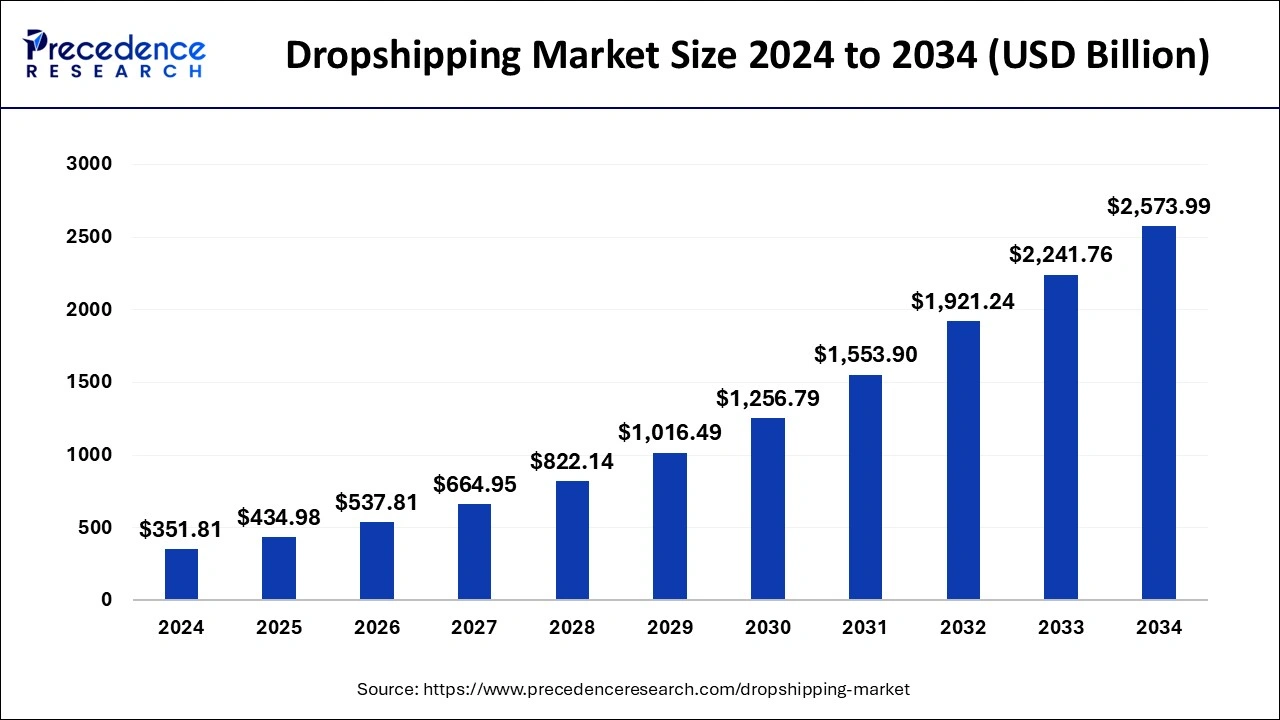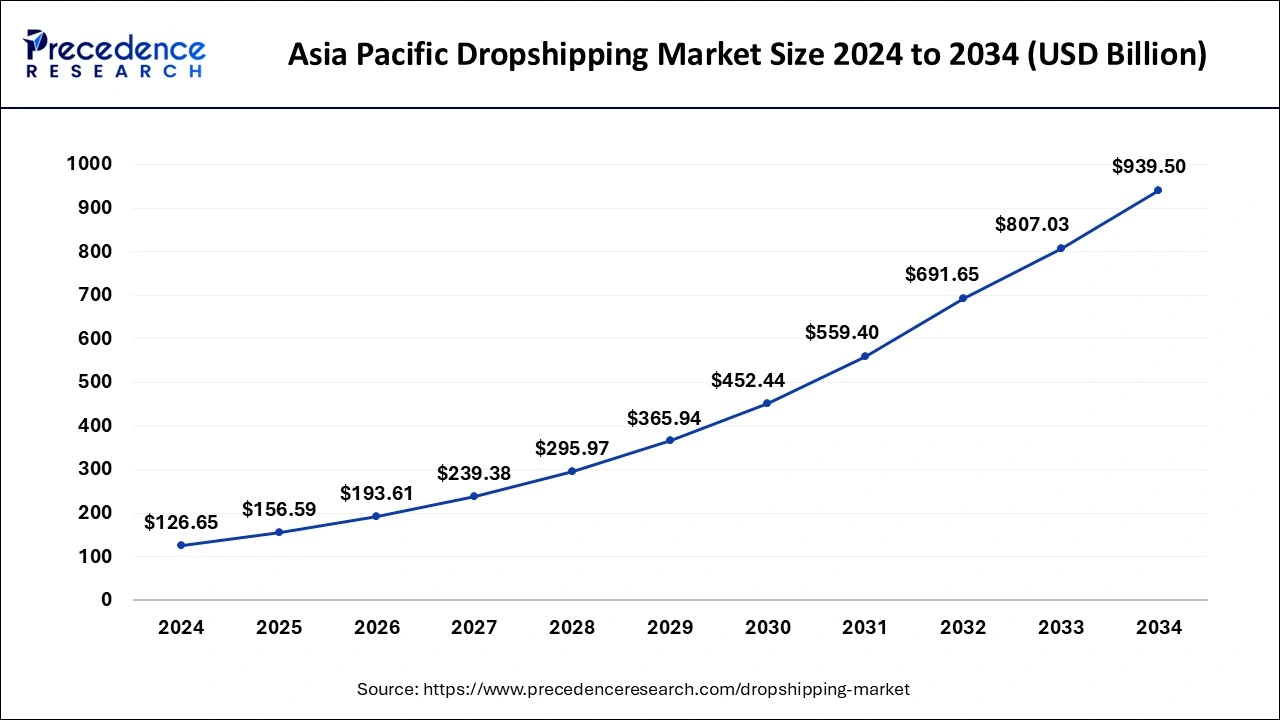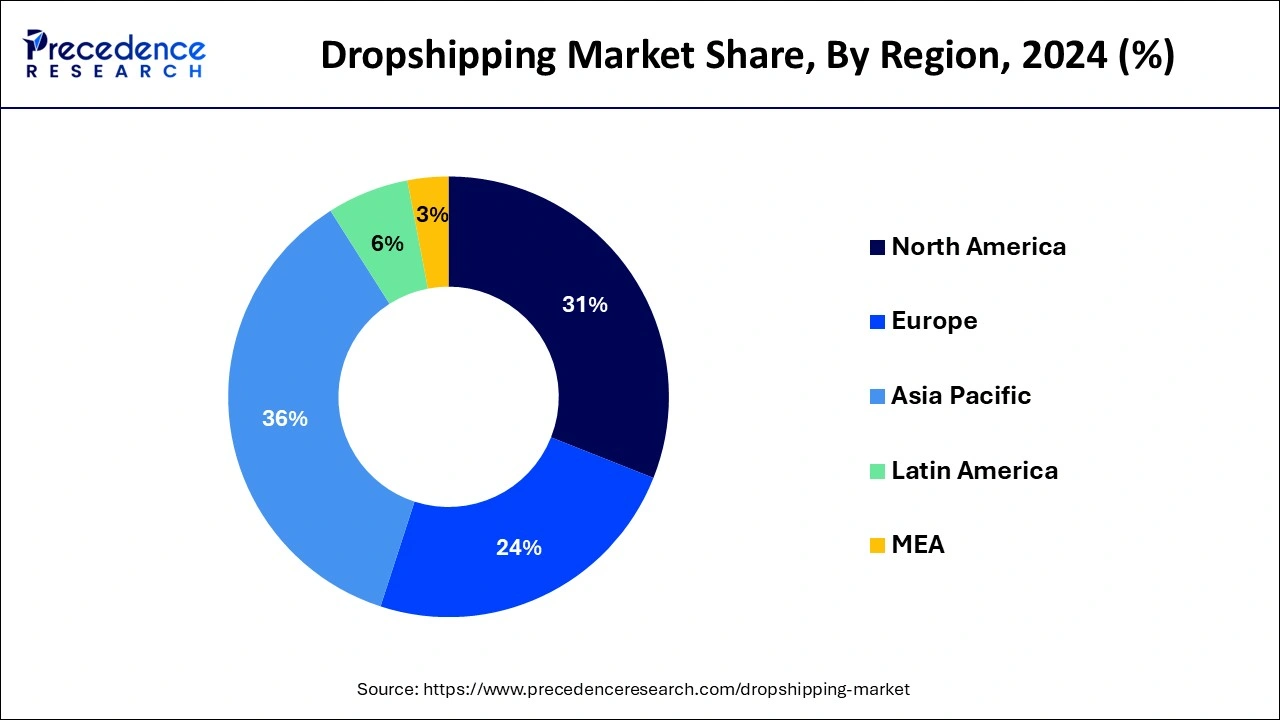The global dropshipping market size was evaluated at USD 351.81 billion in 2024 and it is expected to hit around USD 2573.99 billion by 2034, poised to grow a CAGR of 22.02% during the forecast period from 2025 to 2034. The growing e-commerce business and online ordering trend has significantly boosted the dropshipping market's growth.

AI has a significant role in the development of the dropshipping market as it increases efficiency and improves customer experience. It identifies trending products and brings innovative ideas for packaging that help in the safe delivery of the products. It can provide the personalised facilities required of the customers, which will attract a huge number of people to this market. It can predict the demand of the market and restock products according to requirements, which prevents product wastage. With an automated AI facility, customers can easily inquire about their products at any time.
The Asia Pacific dropshipping market size was estimated at USD 126.65 billion in 2024 and is projected to surpass around USD 939.50 billion by 2034 at a CAGR of 22.19% from 2025 to 2034.

Asia Pacific is expected to dominate the global dropshipping market throughout the forecast period. This is attributable to the rise of the middle class in many Asia Pacific countries which has led to an increase in disposable income and consumer purchasing power. This creates a larger consumer base with greater demand for a wide range of products, which can be effectively met through the dropshipping model. Additionally, the region is culturally diverse, with unique consumer preferences and niche markets. Dropshipping enables retailers to cater to specific market segments by offering specialized products that align with local tastes and preferences. This ability to tap into niche markets is also expected to support the growth of the market within the estimated timeframe.
North America is observed to be the second-largest region during the forecast period. The United States dominated the region’s market in 2024. The rapid growth of e-commerce in the region has created a favorable environment for the expansion of the dropshipping market. Consumers in the region often prefer the convenience of online shopping, driving higher demand for products that can be efficiently fulfilled through dropshipping. Further, consumers in the United States have higher expectations when it comes to fast shipping, product variety, and excellent customer service which is also expected to support the growth of the market. Additionally, the early adoption as well as deployment of modern technologies is also likely to create immense growth opportunities for the regional market in the years to come.

Dropshipping is a fulfillment method where e-commerce businesses delegate the tasks of sourcing, storing, and shipping products to a third party, usually a supplier. This approach is popular among entrepreneurs looking for efficiency and cost savings, although it can impact the customer experience. With dropshipping, products are shipped directly from the manufacturer or wholesaler to the customer, while the dropshipping company serves as an intermediary, offering a range of product categories for consumers to choose from.
Acting as a middleman, a third-party retailer or dropshipping firm forwards customer orders to suppliers at wholesale prices and charges customers the retail price. This transaction is facilitated through an online platform that connects customers and suppliers. The dropshipping market is expected to experience substantial growth, driven by the increasing preference for online shopping and the growing trend of cross-border e-commerce. As a result, the surge in demand for dropshipping services is primarily influenced by the expansion of the e-commerce industry.
| Report Coverage | Details |
| Market Size in 2025 | USD 434.98 Billion |
| Market Size by 2034 | USD 2573.99 Billion |
| Growth Rate from 2025 to 2034 | CAGR of 22.02% |
| Largest Market | Asia Pacific |
| Second Largest Market | North America |
| Base Year | 2024 |
| Forecast Period | 2025 To 2034 |
| Segments Covered | By Product |
| Regions Covered | North America, Europe, Asia-Pacific, Latin America, and Middle East & Africa |
Rising e-commerce sector
The growing e-commerce sector is expected to fuel the growth of the dropshipping market during the forecast period. E-commerce, the buying and selling of goods and services online, has experienced significant growth in the recent years, driven by advancements in technology, changing consumer behavior and increased internet accessibility. As e-commerce continues to thrive, it provides a favorable environment for the growth and proliferation of dropshipping business models.
The increasing popularity of online shopping has created an increase in demand for products that can be conveniently purchased and delivered at the doorsteps of consumers. This shift in consumer behavior has opened up new avenues for the growth of dropshipping retailers. With the use of e-commerce platforms, dropshipping business can reach a wider audience of online shoppers that are actively seeking variety and competitive pricing.
Also, the major key advantage of dropshipping in the e-commerce landscape is its low barrier to entry. Aspiring entrepreneurs can easily set up online stores without the need for substantial upfront investment in inventory. This accessibility has attracted a diverse range of individuals, including solopreneurs and small-scale businesses, which may not have the resources or infrastructure to establish traditional retail operations. Thus, the dropshipping market has experienced significant growth and diversification, with retailers capitalizing on various niches and product categories.
Limited control over inventory and shipping
The limited control over inventory and shipping is likely to limit the growth of the dropshipping market during the forecast period. While dropshipping offers advantages such as low startup costs and streamlined operations, the lack of direct control over these critical aspects can pose challenges for retailers and impact their ability to provide a seamless customer experience. Further, in dropshipping, retailers rely on third-party suppliers to maintain and manage inventory. This lack of control can result in situations where products are listed as available for purchase but are actually out of stock or no longer available. Such discrepancies can lead to customer dissatisfaction, negative reviews, and even damage to the retailer's reputation. Similarly, limited control over shipping can present challenges in ensuring timely and reliable delivery of products to customers.
Dropshipping retailers are dependent on their suppliers to handle shipping and logistics. Delays in order processing, shipping errors, or issues with package tracking can negatively impact the customer experience. Retailers may face difficulties in providing accurate and up-to-date shipping information to customers, resulting in customer frustration and potential loss of repeat business. Thus, this is likely to limit the growth of the market in the years to come.
Rising emphasis on niche markets
The capitalizing on niche markets is likely to offer growth opportunities for the dropshipping market in the years to come. Focusing on niche markets allows dropshipping retailers to stand out from the competition. In saturated markets, catering to a specific niche enables businesses to differentiate themselves and create a unique selling proposition.
By offering products that specifically meet the needs and interests of a particular customer segment, retailers can attract customers who are seeking specialized solutions or unique products. This targeted approach helps build a loyal customer base and increases the likelihood of repeat purchases. Niche markets often have less competition compared to broader markets. By identifying and targeting underserved niches, dropshipping businesses can tap into unexplored market potential. With fewer competitors, retailers have a better chance of establishing themselves as industry leaders within their niche, gaining brand recognition, and capturing a significant market share. This competitive advantage contributes to sustained growth and profitability.
Moreover, capitalizing on niche markets allows for effective marketing strategies. By means of understanding the specific needs, preferences, and pain points of the target audience, dropshipping retailers can tailor their marketing messages and campaigns accordingly. This targeted marketing approach increases the chances of connecting with potential customers and driving conversions. Additionally, niche markets often have dedicated online communities, forums, and influencers that cater to the specific interests of the audience. Collaborating with these influencers and engaging in niche-specific marketing channels can help raise brand visibility and attract a highly engaged customer base. This is expected to create opportunities for the growth of the market in the future.
On the basis of the product, the fashion segment is expected to dominate the market during the forecast period. The fashion industry is highly influenced by trends and changing consumer preferences. Dropshipping allows retailers to quickly adapt to emerging fashion trends by sourcing and offering a wide range of trendy and fashionable products to customers.
The ability to stay updated with the latest styles and designs attracts fashion-conscious consumers and drives demand in the dropshipping market. Also, retailers don't need to invest heavily in stocking inventory upfront, reducing the financial risk associated with carrying unsold or outdated fashion products. This makes it easier for entrepreneurs to enter the fashion market and test different products without the burden of managing inventory. These factors are likely to create opportunities for the fashion segment of the dropshipping market during the forecast period.
The electronics segment is likely to grow at a considerable CAGR during the forecast period. The electronics segment offers a wide range of products, including smartphones, tablets, laptops, gaming consoles, audio devices, smart home appliances, and more. Dropshipping lets retailers access a vast selection of electronics products from various suppliers and manufacturers, providing a diverse range of options to cater to different customer preferences and budgets. The availability of a comprehensive product range drives customer engagement and boosts sales in the dropshipping market.
Also, new electronic devices, gadgets, and accessories are constantly introduced into the market, attracting tech-savvy consumers. It further helps retailers to stay at the forefront of technology by quickly sourcing and offering the latest electronic products to customers. The ability to provide cutting-edge electronics drives demand in the dropshipping market.
By Product
By Geography
For inquiries regarding discounts, bulk purchases, or customization requests, please contact us at sales@precedenceresearch.com
No cookie-cutter, only authentic analysis – take the 1st step to become a Precedence Research client